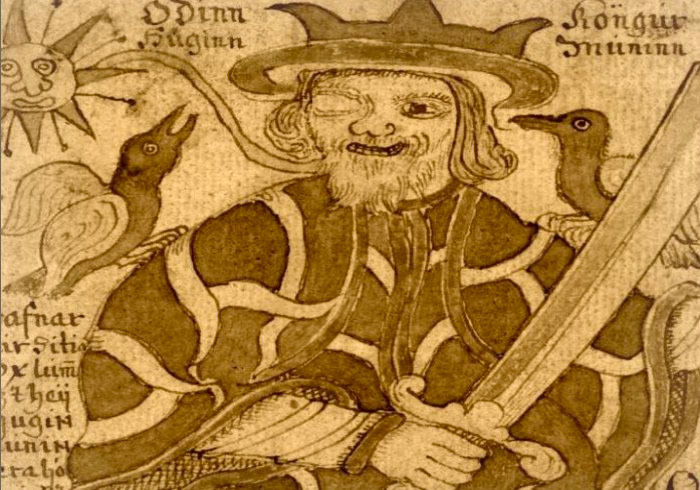“When he sat with his friends, he gladdened the spirits of all of them, but when he was at war, his demeanor was terrifyingly grim.”
Odin was a widely revered god in Germanic and Norse mythology, known in Old English as Wōden, in Old Saxon as Wōdan, and in actuality, went by hundreds of names such as “Master of Ecstasy, Master of Fury or Master of Inspiration,” “The Furious,” “Old One-eye” and “Allfather.” The son of Bor and the giantess Bestla, Odin is the chief of the Aesir and the king of one of the nine realms, Asgard. He is married to the goddess Frigg, and is the father of the gods Thor, Balder, Hodr, Vidarr and Váli. One of the most complex and mysterious gods in the Norse pantheon, first and foremost Odin is the god of War, Battles and Victory, but in Norse mythology, Odin is also the god of wisdom, healing, death, royalty, the gallows, knowledge, sorcery, divination, poetry, frenzy, and the wisdom of the runes. Often depicted with his powerful and angelic battlefield women, the Valkyries or “Choosers of the Dead” collect the best half of those who die bravely in battle, the “Einherjar,” and bring them to his mead hall Valhalla for an eternity of drinking and wrestling and celebration until the end of the world (the other half of the battle fallen are gathered by the goddess Freyja for her afterlife location, Fólkvangr).
Odin takes many forms, but most often he is pictured as a one-eyed old man with a long, grey beard, a heavy cloak and a broad hat. He carries a formidable spear, a named weapon called Gungnir and is accompanied by his animal companions and familiars, the wolves Geri and Freki, and the ravens Hugin and Munin (thought and memory) who bring him information from all over the middle earth. He rides a magnificent flying, eight-legged steed Sleipnir across the sky and into the underworld. In the remaining chronicles we have of Norse and Germanic mythology, Odin takes part in the creation of the world by way of slaying the primordial being Ymir and gives the gift of life to the first two humans, Ask and Embla. He is a continual seeker of greater knowledge, and travels far and wide to gather wisdom, many times in disguise such as his famous exploits in obtaining the Mead of Poetry. Mankind’s knowledge of both the runes and poetry is attributed to him. Odin’s prefers the elite, and this partiality extends to all levels of society, royalty, warriors, poets and shamans alike: In a seeming paradox, Odin is the helper of outlaws and those banished from society for some especially heinous crime. Like Odin, such people were strong-willed warrior-poets who were apathetic to established societal norms. Men and women favored by Odin are distinguished by their intelligence, creativity, and competence in the proverbial “war of all against all.” Because he constantly is drawn to excellence, Odin doesn’t concern himself with average people, preferring to lavish blessings on those whom he deems to be worthy. Of particular importance to him were the berserkers and other “warrior-shamans” whose fighting techniques and spiritual practices center around achieving a state of ecstatic unification with ferocious totem animals, usually wolves or bears, and, thereby with Odin himself, the master of such beasts (berserker means “Bear-shirt”). As the preeminent Norse war-god, Odin is not concerned with the justifications behind any conflict or even its conclusion, but rather with the frenzied encounter inherent in such struggles.
Odin is the ruler of the Aesir tribe of deities, yet he often ventures far from their kingdom, on long, solitary wanderings throughout the cosmos on purely self-interested quests. He’s the war-god but also an effeminate poetry-god, and while he is worshiped by those in search of status, honor, and decency, he’s often cursed for being a capricious trickster. Odin’s competitive side once drove him to challenge the wisest of the giants to a contest to see who was more knowledgeable and learned. The prize was the head of the loser, and Odin won by asking his opponent something that only he himself could know. Odin is often pictured consulting the severed, herb-embalmed head of the wise Mímir for advice. During the foretold events of the end of the world, Ragnarök, Odin is told to lead the einherjar into battle before being consumed by the monstrous wolf Fenrir. Odin personifies the active passion for overcoming any kind of limitation by any means necessary, and he is driven by a unremitting and brutal quest for more wisdom, knowledge, and power, especially magic. To gain expansive knowledge, he sacrificed his eye in Mimir’s well and he threw himself on his spear Gungnir in a kind of symbolic, ritual suicide. His single remaining eye stares in a soul piercing way, a striking feature in descriptions of his countenance. Odin “sacrificed himself to himself” by hanging on the world-tree Yggdrasil for nine days and nights, receiving no form of nourishment from his companions. At the end of this ordeal, he perceived the runes, the magical ancient and mysterious alphabet that held many of the greatest secrets of existence. Along with Freya, his shamanic spirit-journeys are recounted in the sagas. The Ynglinga Saga records that he often “travels to distant lands on his own errands or those of others” while he appears to others to be asleep or dead. Another instance is recorded in the Eddic poem “Baldur’s Dreams,” where Odin rode Sleipnir, his eight-legged horse to the underworld to consult a dead seeress on behalf of his son.
Continued in part 2….

